6 Likes
3 Comments
1 Shares
Why is the hijab such a divisive issue in sports?Iman Amrani sits down with Ibtihaj Muhammad - the first woman to compete for the United States at the Olympi...#AlJazeera #AlJazeeraEnglish #Fencing #GenerationChange #Generationsport #IbtihajMuhammad #Olympics #aljazeeralive #aljazeeraEnglish #aljazeeralive #aljazeeralivenews #latestnews #newsheadlines #explain #muslim #islam #rio #african-american #femaleatheletes #venus #serena #secretlifeofmulims #ellen #bronzemedal #obama #teamusa #2016 #barack #hijab #hijjab #was #pizzagate #firstolipianwearinghijab #firstolympiantowearahijab #hajab #kelseyfingerboards #thefirst
Ibtihaj Muhammad: Hijab and triumph at the Olympics | Generation Sport
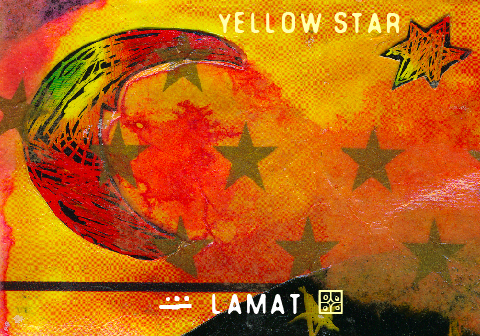
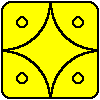
Yellow Star is one of the 20 archetypes to be celebrated by the Maya in their #Tzolkin sacred count. The 20 day signs are represented on our fingers and toes, and the journey through their images tells a creation mythology. Each of us is born on a day of the Tzolkin, and belong accordingly to one of the 20 ‘tribes’ and its teachings. We may embody the ancient icon described in the Mayan stellae – the stone carvings of their temples – or relate to the modernized language of the Tzolkin as channeled by Dr. Jose Arguelles. Through emersion in the calendar count, we can find our own correlations between self and the core images of the day signs. By meditating on the words, images, and our own perceptions of Tzolkin birth energy, we can find another awakening to ourselves and how we relate to the world.
Yellow Star in its Mayan origins specifically salutes #Venus, a celestial jewel so bright it can be seen in day and night skies. Presumably the Maya could not delineate between stars – burning orbs – and planets – solid mass brightly reflecting the sun’s glow, and so when we celebrate Yellow Star we also include both: any glint, spark, that dots the darkened sky.
The #Maya revered Venus for the power of its #shine, more pointedly than its prettiness. They chose their entry into battle based on its placement and ascent. When Venus shone fiercely, so did a warrior. It portended victory, or at minimum virility, and the best chance for triumph. When we contemplate Yellow Star, we might see pure beauty more than the charge of solar strength. For modern audiences, the sky’s truest star power comes straight from the sun. Venus is diminutive, delicate, charming by comparison – that emblem of beauty reserved for pretty women and children in a male chauvinist world.
Yellow Star people get to have it both ways. They can be exceptionally able to present themselves as naturalistically lovely in the world: an artistic flair, great personal grooming and style, a talent for interior design so that they exist seamlessly as a central object of beauty surrounded by so many others. They can also have the essential vibrancy that we call ‘beauty within,’ on fire with life force, burning as a beacon for others to follow and imitate.
This two-fold paradigm means that sometimes they are reflecting the sun against their face, and sometimes have the sun at their core. Either way, their nature is to be bright a point of illumination within darkness. They know how to situate themselves where their beauty stands out and serves best to guide and inspire. Sometimes that’s where it’s all dejected and depressive hardship – they volunteer in rough terrain, help causes of the downtrodden – and sometimes it’s among a sea of other splendid light-givers. Not so much in between, an average or haphazard life, unchanging. Like their namesake, Yellow Star people are ever on a smooth moving circuit through life experience, unafraid of the unknown, and probably received like a light ambassador most places they turn up, at minimum appreciated for their grace and good looks.
Yellow Star is diminutive of Yellow Sun, the big star we also venerate in the Tzolkin. It’s like a sun-seed, or an heir waiting to become the emperor with all the potential for that grandeur. Yellow Star people don’t get overly preoccupied with big concepts like enlightenment, divinity, being on fire for the heavenly presences. Yellow Star people like being the ambassadors of the sun and representing that larger light field wherever they go, with less pressure to figure it all out for those following, offering every answer. They like to shine, have attention, fill people’s dark voids with joy, hope, and something special to gaze upon. But they don’t force a hard sell about seeking and attaining the light. Rather their presence is spell-binding: be here now in this beauty.
If it sounds a bit etheric, that’s because Yellow Star people are often burning embers occupying outer space. They live in the sky with the other spots of brilliance, like angels or shooting streaks of inspiration. Of course, Venus is a planet, a solid mass, only reflecting the sun. Here the Yellow Star is a bit of a charlatan, happy to seem like a small sun swirling close when their resilient glow is just a power far outside and away that plays off the blank canvas of their features.
Going back to the idea of war, Yellow Star people can have an imperious beauty, a prettiness that also forces confrontation. It doesn’t sit simply like the petals of a flower, but moves and agitates and reacts like a lithe animal. Yellow Star calls you to your power, emboldens you, dares you to find the fire inside you, or to face the sun and absorb its light. Don’t disappear into the darkness, don’t be outside the star sheen of the night sky, be a part. Join the army of light bearers, have sunlight as your standard even as you enter its shadows.
Yellow Star’s action – its direction in life – is to beautify. Any environment benefits with light and enchantment from this tribe’s spark. Yellow Star people will actively seek to improve the look and feel of spaces they enter, and anyone there will absorb or reflect the glow that they emanate. Harmony is another form of beauty, so it’s not all visuals, looks, surface sheen. The tribe also calms, softens, sweetens with its presence. The mission of a Yellow Star is to improve life through making it more potent and virile (on fire from within), and more de-light-ful, shiny, brilliant (making sure you capture some of the sunshine they reflect).
Yellow Star’s power – its offering to strengthen us in turn – is elegance. There’s just nothing rough and clumsy here, only movements with poise and grace. This is like the trajectory of Venus through the more fixed constellations, bedazzling different mythic creatures on its tour around the sun. It slips by, elevates what it passes with its pretty features, must sail on. There’s not a lot of fiery confrontation in Yellow Star, even if its nature is the flame. It has a palatable amount of intensity, meted out in pulses of pretty light, enough to make us want to stay close, share this gentle form of receiving enlightenment, see our dark phases have sparkle.
Yellow Star has the essence of art. So much of Yellow Star demands an audience, someone to wish upon them, aim for them, feel their power. They are like works of art to gaze upon, study closely, aspire to imitate. They are like artists themselves, creating objects to brighten the landscape of dull, muted moods and heavy metal machinery. A Yellow Star passage will be full of pretty things that we suddenly can’t help but remark upon: life is beautiful. Yellow Star people embody, attain, produce a beautiful life. Again, it can be surface, a bit of the sun caught in their visage. Or it can be from the very center-point of their warm heart. There are giant stars and lesser stars, of all different gaseous colors. But what they share is our attraction to them, our sense of solace in untouchably precious light and pretty orbs.
Yellow Star is antipodal, opposite, to White Mirror. White Mirror is a sacrificial act or offering that clears space for us to directly behold divinity. Yellow Star is so far from any sense of loss, even one that begets a greater gift. Yellow Star is a gemstone, making us feel blessed, endowed, when it appears before us. Both lead us to the sun, however, on different paths. Yellow Star’s is direct, unobstructed but possibly the easier way with some vanity and superficiality intact. White Mirror’s is violent and heartbreaking, a public feat of intense bravery, where we are carved into a posture of humility, surrender. Even if it’s not literal, at its essence White Mirror is joining god more fully when our fear and resistance is cut away. Yellow Star people benefit from the embrace of something so raw, rigorous and drawn from the shadows. It makes them more balanced.
Yellow Star is analogous, supported by Blue Monkey. Children like to see count stars, sing about stars, see the first one that blooms from the dusk sky. Blue Monkey is the child self, the inherent magician with a wild imagination that is under all the layers of aging through a human lifetime. Blue Monkey likes beautiful things to collect and display, simple treasures, more than what their undeveloped minds can’t process like dark parental moods and societal trauma. They gaze upon the stars and all is soothed for a while. Yellow Star likes an audience, and children – the Blue Monkey essence – offer that easily, a spellbound lot. Yellow Star likes being the benevolent center of attention, basking in the ease of just being aglow. No logic and reason demanded, just a spark to dispel darkness.
Yellow Star has a mystical, occult relationship to Red Skywalker. Easily, they are both launched into the heavens, one as a fixture the other as passerby. They bounce mystery off one another like a sailor who meets the sea, or better: the mermaid in its swells. Red Skywalker is a day-tripper mostly, entering a light blue expanse where stars give way to clouds and the sun’s supremacy. The stars are not a focal point when the greatest sun-star has supremacy. In this way Red Skywalker is unfazed by Yellow Star, more objective and unfawning. Really, when Red Skywalker enters the sky it becomes a star itself, this is how humans access the heavens through a prophet’s eyes. Yellow Star finds an ambassador from earth who is at heart her equal, another figure with five points who lights up the dark. Their occult intimacy is much like falling in love.
If you are guided Yellow Star, you are drawn to beauty in all forms, and the clear order of it, light backdropped by dark, not ignorant of each but your attention always on the luminescence. You might be called routinely to tribal wars – expressions of your strength, power and fearlessness – but they are in service not of human hungers, but the sun god’s ultimate enterprise of creating harmony.
Kin:228
Tone: 7 Resonant
Inspiring * Attunement * Channel
Tribe: 8 Star
Beautify * Art * Elegance

#'mayan - 1 akbal
#Haab - 11 chen
Yellow Resonant Star
Green Central Castle of Enchantment
Earth family- Signal Clan- Blood
I channel in order to beautify
Inspiring art
I seal the store of elegance
With the resonant tone of attunement
I am guided by the power of universal fire

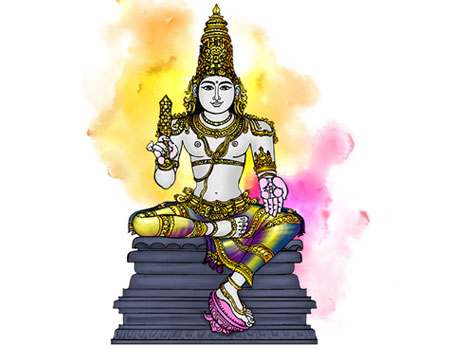
#Purvaphalguni #Nakshatra
#Purva #Phalguni (The Former Red One or A Fig Tree) (133°20′ to 146°40′ #Leo)
Purva Phalguni nakshatra consists of two bright stars in the night sky Zosma (Delta Leonis) and Chertan (Theta Leonis). These #stars are in the constellation of Leo, positioned to the left of the bright star Regulus. Purva Phalguni is represented by the #front legs of a #bed, which signify rest, rejuvenation and pleasure. The ruling deity #Bhaga, the God of delight, bestows affection and sexual passion. #Venus, the planetary ruler of this nakshatra, brings an appreciation for relationships, beauty, and luxury.
Purva Phalguni nakshatra is the most theatrical and carefree of the nakshatras. Those born under this nakshatra desire recognition for their accomplishments, yet they must be cautious of laziness or pretentious behavior. This is truly a star of relaxation, recreation and sometimes vanity. Purva Phalguni gives the energy of renewal and contentment through the love of art and creativity.
Sacred Energy Vortex
#THIRUVARANKULAM #SRI #HARI #THEERTHESWARAR
The sacred energy vortex for the #star of Purva Phalguni is located in Thiruvarankulam, close to Alangudi in Tamil Nadu, India. People born under this star should visit Sri Hari Theertheswarar temple at least once during their life time.
The Purva Phalguni (Pooram) theertha, is one of the sacred bathing ghats in the world of Lord Fire. (A ghat refers to a stairway leading to a body of water). In the realm of Purva Phalguni nakshatra, there are seven theerthas Siva Theertha, Gnana Brahma Theertha, Naga Theertha, Indra Theertha, Skandha Theertha, Sri Theertha and Guru Theertha. All seven of these theerthas are not visible to the naked eye. Only after taking a holy bath at one theertha, do the other theerthas become visible. Therefore, the path to the Guru Theertha is only visible to those who have taken a holy dip in the other Theerthas on the Purva Phalguni star day. Due to divine grace, the sacred temple at Thiruvarankulam Sri Hari Theertheswarar contains all seven of these theerthas. Siddhas proclaim this as an important site of worship for those born Purva Phalguni star, as these peopleare capable of receiving the darshan of the precious theerthas. People born in Purva Phalguni nakshatra have a powerful connection with water, and they will benefit greatly from taking a holy bath at these sacred vortexes as frequently as possible.
After performing penance, #Goddess #Aadippoora was granted the fortune of receiving several darshans of Lord Shiva on the Purva Phalguni star day during the month of Adi. Those born under Purva Phalguni would also benefit from a visit to this significant sacred shrine on their birthday, Purva Phalguni day, AdiPooram (Purva Phalguni day in the month of Adi), and on their wedding.
Purva Phalguni nakshatra natives, your #incense is made with the #herb #Palalsh as prescribed by the Vedas.
Burning one of these pillars is like performing a mini fire ritual for that particular star formation. For your specific Birthstar, you will be able to connect inwardly to your planet of energetic origin and gain support with the positive aspects that are you.
Burning the other Nakshatra pillars on that specific Nakshatra day will tune you in with the favorable activities with that star’s energy for the day. It is recommended to at least burn your own personal Nakshatra pillar daily to stay connected to your essence. It is advantageous to burn the days Nakshatra pillar as well.
https://www.astroved.com/astropedia/en/nakshatra/purvaphalguni-nakshatra

#PurvaAshadha #Nakshatra - Purva Ashadha is the twentieth Nakshatra in #Vedic #astrology ranging from 13°20' to 26°40' Dhanu.
Symbol - The symbol of this Nakshatra is an #elephant #tusk, #fan and winnowing basket.
Astronomical Name - The astronomical names of this Nakshatra are δ and ε Sagittarii.
Deity of Nakshatra - #Apah, the god of Water is the deity of Purva Ashadha Nakshatra.
Ruling Planet - Purva Ashadha Nakshatra is ruled by Shukra (the planet #Venus).
Others - Purva Ashadha means 'early victory' or the 'undefeated, the unsubdued'. The native of the Purvashada Nakshatra possesses with the divine gift of articulate speech. These natives can be very impulsive and argumentative so that it is difficult for anyone to beat them in any debate.
https://www.drikpanchang.com/tutorials/nakshatra/purva-ashadha-nakshatra.html
Shocking #Predictions for #September #2023 - The Journey to 2030 Begins
Source: https://youtube.com/watch?v=wlLw1CqCl7w
Description/Index timestamps:
00:00 introduction
6:14 #Mercury
7:20 #Venus and #Jupiter
10:45 #Mars
12:24 #Rahu and #Ketu
20:00 September 22, 23 and 24 for USA
About the content creator:
Welcome to #Vedic Living #Astrology - your one stop resource on everything to do with Vedic sciences. At Vedic Living we teach clients how to combine Yoga, Vedic Astrology, Vedic Philosophy and Ayurveda to live a fulfilling and wholesome life, physically, mentally, spiritually and emotionally. Shree is a writer, teacher, and certified (Master of Arts in Vedic Astrology) astrologer who has to date helped hundreds of clients. She is also a senior faculty at the University of Vedic Astrology, and takes great joy in teaching aspiring astrologers. Shree has a 200 RYT certification in Yoga and Meditation. She emphasizes on the connection between chakras in one's energetic body and planets in one's natal chart. The birth chart also reveals your Ayurvedic composition (Tridoshic balance), hence making it once again a very useful tool in Ayurveda

#PurvaPhalguni #Nakshatra - Purva Phalguni is the eleventh Nakshatra in #Vedic #astrology ranging from 13°20' to 26°40' Simha.
Symbol - The symbol of this Nakshatra are front legs of #bed, #hammock or #fig-tree.
Astronomical Name - This Nakshatra is corresponding to δ and θ Leonis.
Deity of Nakshatra - The deity of Purva Phalguni Nakshatra is #Bhaga which is known as the god of good fortune and prosperity.
Ruling Planet - Purva Phalguni Nakshatra is ruled by Shukra (the planet #Venus).
Others - Purva Phalguni is considered to be the Nakshatra that bring good fortune and luck. It is the #birth star of #Brihaspati.
https://www.drikpanchang.com/tutorials/nakshatra/purva-phalguni-nakshatra.html

#Bharani #Nakshatra - Bharani is the second Nakshatra (lunar mansion) in #Vedic #astrology ranging from 13°20' to 26°40' Mesha.
Symbol - The symbol of this Nakshatra is #Yoni (the female organ of reproduction).
Astronomical Name - Bharani Nakshatra is represented as 35, 39 and 41 #Arietis.
Deity of Nakshatra - #Yama, the God of Death is the deity of this Nakshatra.
Ruling Planet - Bharani Nakshatra is ruled by the planet Shukra( #Venus).
Others - Bharani is a bright and active Nakshatra and works as harmful and misleading in nature. The energy of Bharani is called ugra or krura.
https://www.drikpanchang.com/tutorials/nakshatra/bharani-nakshatra.html
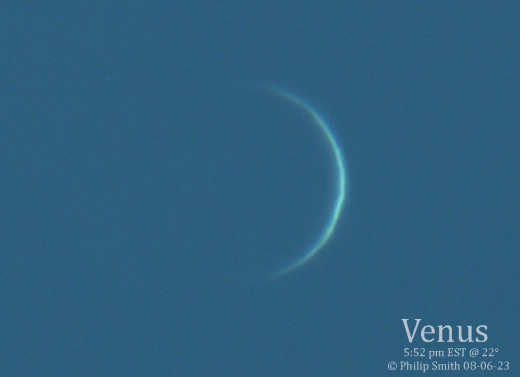
Observing #Venus this week may be one of the most dangerous things you can do with a telescope. The planet is only 12 degrees from the #sun. The results, however, are undeniably #beautiful:
Philip Smith took the picture in broad daylight on Aug. 6th from his home in Manorville, NY. "This is exactly how it looked," he says. "The colors have not been altered."
Like the Moon, Venus has phases, and at the moment it is a marvelously thin #crescent. This only happens during a special time called "inferior conjunction" when Venus passes between the sun and Earth. This year's inferior conjunction is less than a week away on Aug. 13th--so now is primetime for catching the crescent.
Smith explains how he did it: "The hardest part was finding Venus with the sun so nearby. I put solar filters on my telescope and started with the sun to get a good sharp focus. Then I had the telescope go to Venus. I took off the finder scope's solar filter first and put my hand behind it to make sure the sun was not in its path. Then I removed the main telescope's solar filter--and all was good!"
At closest approach on Aug. 13th, Venus and the sun will be separated by a little more than 7 degrees. This means careful daytime shots of Venus will be possible throughout the conjunction.
https://spaceweather.com/
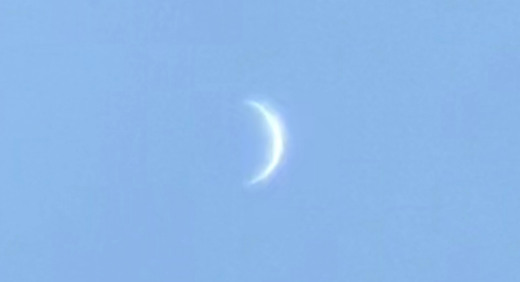
#CRESCENT #VENUS: Yesterday in Bayside, New York, Elias Bonaros saw a bright silvery crescent in the daytime #sky. It wasn't the Moon. "It was Venus!" says Bonaros, who photographed the second planet in broad daylight:
Like the Moon, Venus has phases, and that is why it sometimes looks like a crescent. The next two weeks are a good time to observe this phenomenon. On Aug. 13th, Venus will pass almost directly between Earth and the sun--an event astronomers call "inferior conjunction." Between now and then, Venus will be turning its nightside toward us, transforming itself into a dark disk outlined by a curved sliver of the planet's sunlit cloudtops.
At closest approach on Aug. 13th, Venus and the sun will be separated by a little more than 7 degrees. This means careful daytime shots of Venus will be possible.
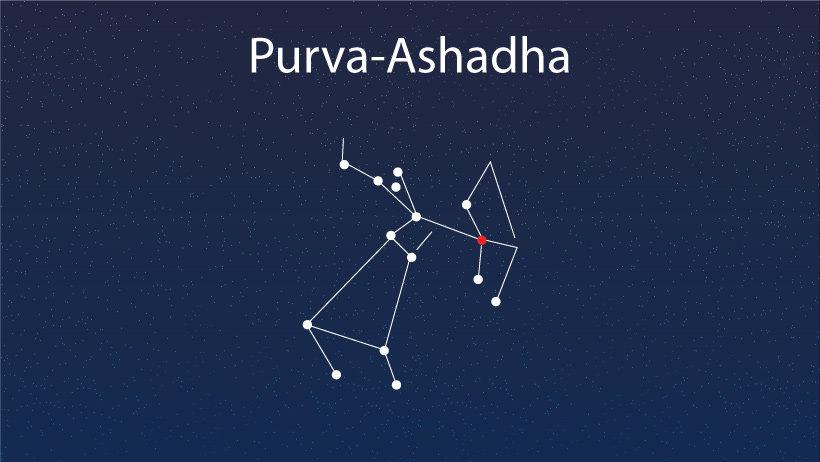
#Purva-ashadha #Nakshatra is the 20th of 27 #nakshatras. If you were born when the moon was between 13:20-26:40 degrees #Sagittarius
#Sanskrit Name: पूर्वाषाढ ( #PurvaAshadha) comes from the Sanskrit words पूर्व (early) and अषाढ ( #invincible). One meaning of Purva-ashadha is “the early invincible one,” indicating eagerness, power, and steadfastness.
Planetary Ruler: #Venus. The Ancient Romans worshipped Venus as the goddess of desire, sex, and sensuality. Venus is associated with material pleasures and prosperity, an enjoying #spirit, and the #arts.
Nakshatra Group: Human. Nakshatras are divided into three classes — monsters, humans, and gods. Purva-ashadha is a human nakshatra. People in this group are generally hardworking and motivated to achieve material success. Although they are generally kind, they can also be vindictive and self-serving.
Zodiac Sign: Sagittarius. Sagittarians are fortunate and righteous. They are wise, warm-hearted, and spiritually-inclined.
Deity: #Apah. In #Vedic theology, Apah is the consort of #Varuna, and together they preside over the #water element and all bodies of water, such as rivers, lakes, and oceans. Additionally, Apah and Varuna rule over all aquatic beings.
Symbol: A #winnowing #basket. This represents popularity, purity, and discernment.
Power: To invigorate. Persons born under the star of Purva-ashadha are filled with energy. They are able to inspire others and can sacrifice themselves for a higher cause.
Resonant Syllables: In India, the birth nakshatra is traditionally used as one means of choosing the name of a child. The corresponding syllables for the four quarters (padas) of Purva-ashadha are Bhu (भू), Dha (धा), Pha (फा), and Ḍha (ढा). The syllable of a person’s first name is sometimes used when calculating an astrological chart if the time of birth is unknown.
Strengths
Purva-ashadha natives are courageous and ambitious souls. They are able to develop a strategy for action and see it through. Their above-average intelligence allows them to foresee potential problems, opportunities, and other areas of concern, and adjust their approach to any given task accordingly.
Those born under purva-ashadha are dignified, modest, and honest. They can encourage and empower others, and they give credit where it’s due. They strive to hold themselves to a high standard, and they bring out the best in those around them. Their upstanding behavior brings admiration and respect from their peers.
You have a sharp wit and a good sense of humor. You are peaceful, happy, and optimistic. Your strength of character helps you remain cheerful even in the midst of trying circumstances, and you can be a leader for your local community.
Purva-ashadha Careers
Persons born in Purva-ashadha can do well in careers that involve education or leadership. You may work very hard for little to no compensation if it is a cause that you value and believe in.
Some ideal professions include:
Any water-related profession
Writer, editor, or publisher
Politician, public speaker, or lawyer
Psychic, counselor, or priest
Weaknesses
Purva-ashadha natives don’t take criticism well. They can be somewhat proud and may not be open to hearing others’ perspectives or opinions. This can lead to a superiority complex, wherein one feels himself inherently better than others. Although you do have many strengths and advantages others lack, on the spiritual platform, we are all fundamentally equal spiritual beings, part and parcel of the Supreme. Humility, compassion, and a sincere desire to serve others are all necessary ingredients for a fulfilling and progressive life.
Persons born under the star of Purva-ashadha may be workaholics and overachievers. They have a hard time letting go of things and must always strive for a perfection that is forever out of reach. This can be very frustrating, and can also result in indecisiveness, always second-guessing whether or not one’s endeavors are truly worth the effort.
You are loud and vocal about your opinions. You may be perceived as obnoxious by those who disagree with you. Be careful to consider how your words and actions impact those around you. If you dedicate your life to God consciousness, you will be able to overcome your lower nature and find fulfillment even in the ordinary activities of life.
Recommended: Learn more about science of the Vedas and how Vedic knowledge can help you elevate your consciousness and enhance your life.
Other Personality Traits
You are a mature person and can give good guidance to others. You are a very thoughtful and intelligent person, and you naturally take on the role of an advisor. This is one of your greatest strengths. However, it can lead to excessive feelings of pride and cause you to feel superior to others.
You have a deep and abiding faith. You are a moral person and you tend towards theism. However, this may manifest in a more generic way. You enjoy learning about world religions and finding the common connection between them. If you can seriously take up an authentic spiritual path, you will find immense satisfaction.
You are popular. Purva-ashadha natives have many good qualities and are often adored and appreciated by others.
Purva-ashadha Compatibility
Purva-ashadhas’ sexuality is symbolized by a male monkey. In terms of physical compatibility, this makes them an ideal match for persons born under Shravana nakshatra.
Based on holistic matching, Purva-ashadhas are most likely to find happiness in long-term partnerships with:
Ashwini
Bharani
Krittika in Aries
Ardra
Magha
Purva-phalguni
Uttara-phalguni in Leo
Mula
Uttara-ashadha in Sagittarius
Shatabhisha (for male natives)
Purva-bhadrapada in Pisces
Uttara-bhadrapada (for male natives)
Note: Compatibility in relationships is a complex science that looks at many different factors. You should always consult with an experienced astrologer who can carefully analyze the charts of both you and your partner.
Purva-ashadha’s Four Quarters (Padas)
Each nakshatra is divided into four quarters, also known as padas, of 3:20 degrees each. These quarters are based on a 1/9th divisional chart, known in Sanskrit as navamsha.
The moon’s position at your time of birth determines the quarter in which you are born.
First Quarter (13:20-16:40 degrees Sagittarius): Leo. You are high-minded and dignified. You respect others and are admired by your peers. You enjoy helping others, and you lead a stable, happy life.
Second Quarter (16:40-20:00 degrees Sagittarius): Virgo. You are intelligent and philanthropic. You have a natural flair for directing others.
Third Quarter (20:00-23:20 degrees Sagittarius: Libra. You are intelligent and philanthropic. You have a natural flair for directing others.
Fourth Quarter (23:20-26:40 degrees Sagittarius): Scorpio. You are spiritually-inclined and have a gentle disposition. You are cautious when entering into new relationships or major commitments. This is a good quality. You will accomplish great things in your life.
Purva-ashadha in Electional Astrology
In electional astrology, also known as muhurtha, nakshatras are used to determine favorable days and times for important ceremonies and events, such as weddings, buying a new house or vehicle, commencing a project, or conceiving a child.
The electional nature of Bharani is Krura or Ugra, “fierce” and “harsh.” Bharani is an excellent nakshatra for:
Giving up bad habits
Cutting off toxic relationships
Quitting a job
Any destructive act, such as weeding or demolition
Performing vows or retreats, such as a day of silence
Doing any kind of detox or cleanse
https://popularvedicscience.com/astrology/purva-ashadha-nakshatra/
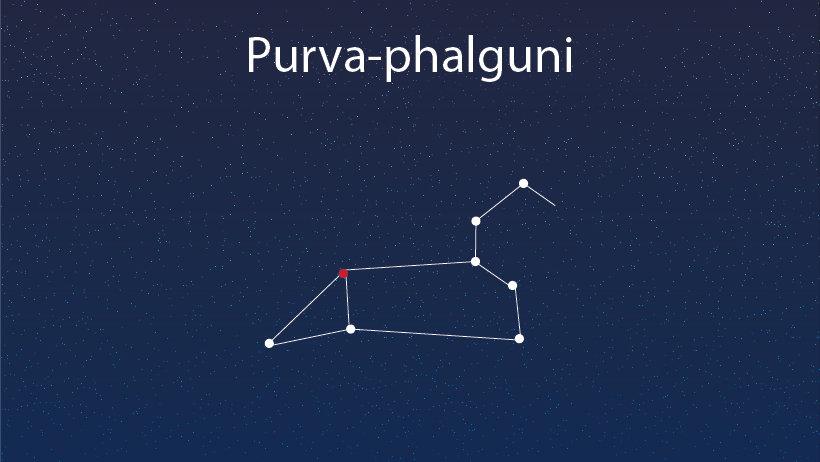
#Purvaphalguni #Nakshatra is the eleventh of 27 #nakshatras. If you were born when the moon was between 13:20-26:40 degrees Leo
Sanskrit Name: पूर्व फाल्गुनी (Purva-phalguni) comes from the Sanskrit words पूर्व (early) and फल्गु (spring season). One meaning of #Purva-phalguni is “the early reddish one,” indicating the color and fresh life of new spring, sensuality, and a youthful nature.
Planetary Ruler: #Venus. The Ancient Romans worshipped Venus as the #goddess of desire, sex, and sensuality. Venus is associated with material pleasures and prosperity, an enjoying spirit, and the arts.
Nakshatra Group: Humanlike. Nakshatras are divided into three classes — monsters, humans, and gods. Purva-phalguni is a humanlike nakshatra. People in this group are generally hardworking and motivated to achieve material success. Although they are generally kind, they can also be vindictive and self-serving.
Zodiac Sign: Leo. Leo is famously associated with the king of the jungle, the lion. Leos are powerful, brave, big-hearted individuals who may struggle with pride.
Deity: Surya ( #Aryaman). In #Vedic theology, Surya is the lord of the #sun and is revered as an expansion of God. The sun god is worshiped prominently in many cultures and is known to bestow favors and fortune on his worshippers.
Symbol: #Hammock. This represents rest, rejuvenation, sex, and pleasure.
Power: To create. This creative ability is associated with begetting children, giving birth, and literally and figuratively bringing things into existence.
Resonant Syllables: In India, the birth nakshatra is traditionally used as one means of choosing the name of a child. The corresponding syllables for the four quarters (padas) of Purva-phalguni are Mo (मो), Ta (टा), Tee (टी), and Tu (टू). The syllable of a person’s first name is sometimes used when calculating an astrological chart if the time of birth is unknown.
Strengths
Natives of Purva-phalguni are characterized by their zest for life. You have a youthful energy, always eager for new experiences and ready to act. It’s almost impossible not to have fun in your company. Happiness seems to go hand in hand with your exuberant, carefree nature.
You seem to be good at everything you do. You are artistic, musical, and have a great love for all the fine arts. You are a true romantic. You have a refined sense of pleasure — you love to enjoy and you do it well. You may become wealthy, and are charitable with that wealth.
Anyone you meet will be struck by your air of elegance. You keep yourself clean and dress well, speak eloquently, and have a good sense of humor. You won’t be caught speaking raucously or acting unrefined in any way. Invariably soft-spoken, you create a sense of gentleness and sophistication.
Sociable by nature, you love to spend time with friends and make new acquaintances, and you’ll have a good deal of influence over those around you.
Purva-phalguni Careers
Your confidence and your creativity make you well-suited for leadership roles where your ideas can be utilized. Positions where you can use your skill with people will also be satisfying for you.
Some ideal professions include:
Actor/actress, musician, artist, or model
Entrepreneur, C-level executive, or manager
Teacher, professor, or personal trainer
Therapist or counselor
Fashion, cosmetics, photography, or the wedding industry
Weaknesses
Your need for excitement and your constant craving for sensual stimulation can get out of hand — it can make you impulsive, reckless, and excessively passionate. In your endless search for new experiences, you may be forced to explore increasingly questionable territory.
Right and wrong don’t hold a lot of sway over you, and you may be drawn to behavior that could be harmful to yourself or to others just for the novelty of it. You may behave promiscuously, overly eager for sexual pleasure. You have a tendency towards addiction and indulgence. Money can pass too quickly and too extravagantly through your hands.
Since pleasure is your primary motivation, you can be lazy and unmotivated when it comes to activities that aren’t particularly enjoyable. If you give in to this inclination, practical tasks will be left undone and your life could become unstable.
Vanity is one of your greatest weaknesses, and you can come across as entitled or pretentious. You generally experience good fortune in your life — talented, attractive, and charismatic, you often feel like you’re on top of the world. Be conscious of the privilege you experience or you may use it as an excuse to look down on others.
Purva-phalgunis will ultimately experience greater satisfaction in life by cultivating humility and gratitude, and grounding themselves by setting boundaries for their sensual pleasures.
Recommended: Learn more about the science of the Vedas and how Vedic knowledge can help you elevate your consciousness and enhance your life.
Other Personality Traits
You feel lucky. Your life is generally one of good fortune, and your natural optimism helps you find the silver lining in even the darkest of clouds.
You might be selfish. Your love for enjoying can make you somewhat self-centered. You might seem almost ruthless in the pursuance of your own pleasure, at the expense of others.
You take responsibility for your actions. You might do some pretty crazy things in the heat of the moment, but you are always ready to deal maturely with the consequences.
You may go into debt. Because of your love for living life to the fullest, you might live above your means. Be mindful to keep track of your expenses, and be ready to limit yourself sometimes. A budget might be helpful.
Purva-phalguni Compatibility
Purva-phalguni sexuality is symbolized by a female rat. In terms of physical compatibility, this makes them an ideal match for persons born under Magha nakshatra.
Based on holistic matching, Purva-phalgunis are most likely to find happiness in long-term partnerships with:
Ashwini
Bharani
Krittikas in Aries
Mrigashiras in Gemini (for male natives)
Ardra
Magha
Uttara-phalgunis in Leo
Mula
Purva-ashadha
Uttara-ashadhas in Sagittarius
Purva-bhadrapadas in Aquarius (for male natives)
Note: Compatibility in relationships is a complex science that looks at many different factors. You should always consult with an experienced astrologer who can carefully analyze the charts of both you and your partner.
Purva-phalguni’s Four Quarters ( #Padas)
Each nakshatra is divided into four quarters, also known as padas, of 3:20 degrees each. These quarters are based on a 1/9th divisional chart, known in Sanskrit as navamsha.
The moon’s position at your time of birth determines the quarter in which you are born.
First Quarter (13:20-16:40 degrees Leo): Leo. You have a regal presence and an impressive strength of will. You are opinionated and can be egoistic, and demonstrate a fiery intensity when you feel challenged. Your ambitions could take you far in life.
Second Quarter (16:40-20:00 degrees Leo): Virgo. You have a calming, grounding effect on the world around you. Because of your practical and balanced outlook, you deal well with stressful situations. Hard work doesn’t faze you. You have a natural talent for writing.
Third Quarter (20:00-23:20 degrees Leo): Libra. Your soft heart makes you more compassionate than other Purva-phalgunis might be. You like to help people, and would do well as a counselor — a role which you fall into almost automatically. You are generally relaxed and are highly creative.
Fourth Quarter (23:20-26:40 degrees Leo): Scorpio. You are happy to make sacrifices for the sake of the common good. Like a hero of old, you are virtuous and courageous in the face of danger. You can be intense, and may experience more hardships than other Purva-phalgunis.
Purva-phalguni in Electional Astrology
In electional astrology, also known as muhurtha, nakshatras are used to determine favorable days and times for important ceremonies and events, such as weddings, buying a new house or vehicle, commencing a project, or conceiving a child.
The electional nature of Purva-phalguni is Krura or Ugra, “fierce” and “harsh.” Purva-phalguni is an excellent nakshatra for:
Giving up bad habits
Cutting off toxic relationships
Quitting a job
Any destructive act, such as weeding or demolition
Performing vows or retreats, such as a day of silence
Doing any kind of detox or cleanse
https://popularvedicscience.com/astrology/purva-phalguni-nakshatra/